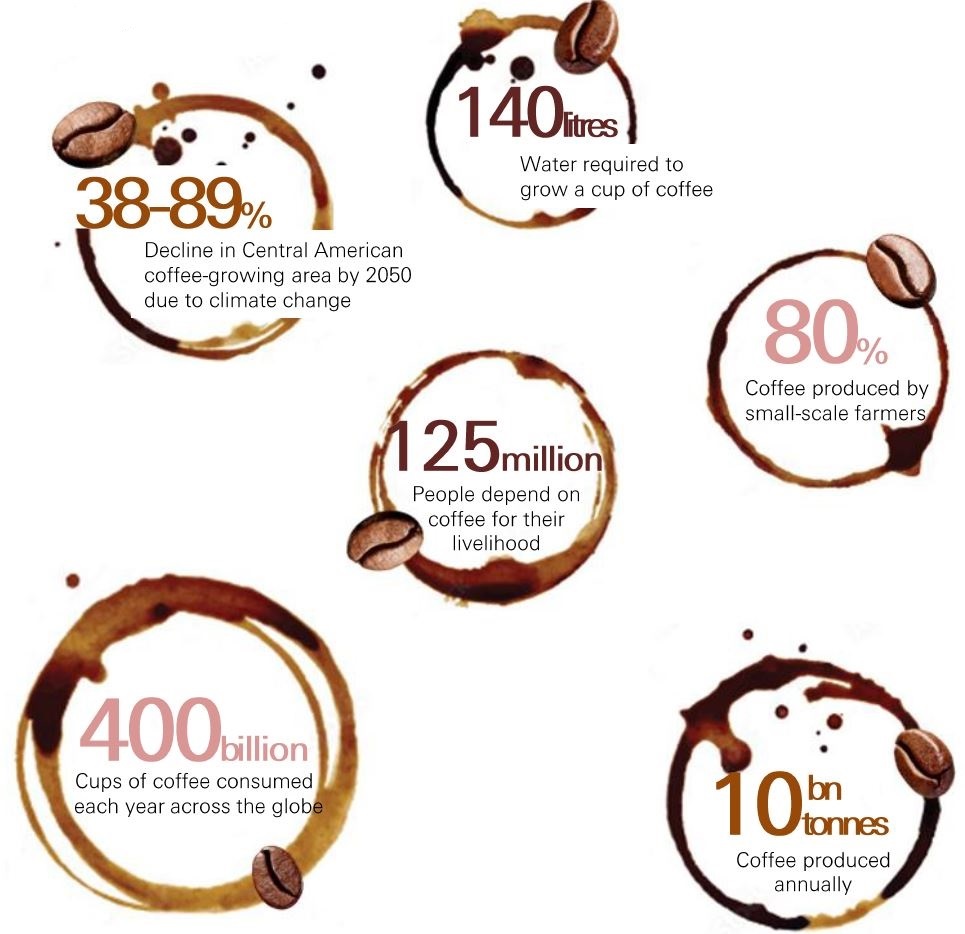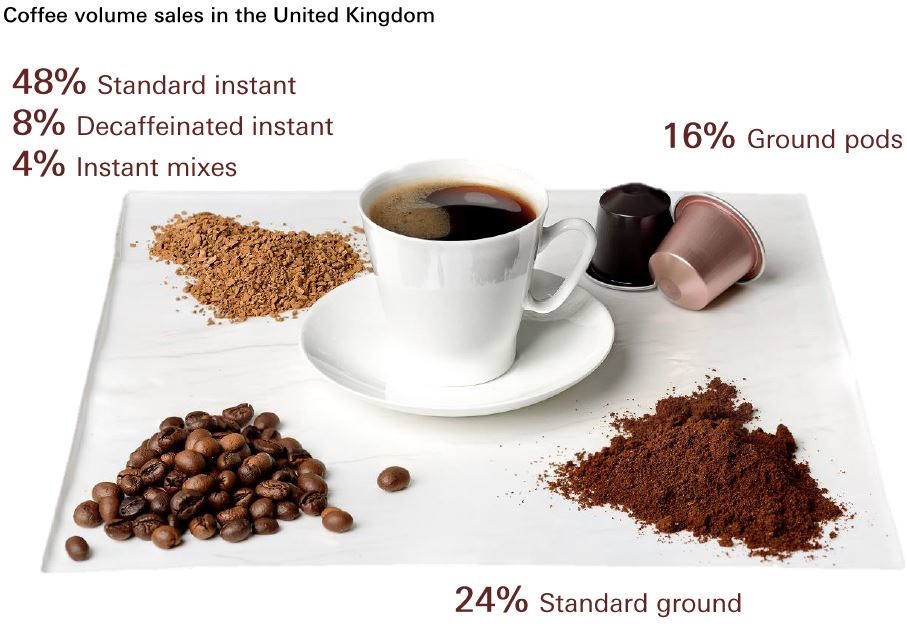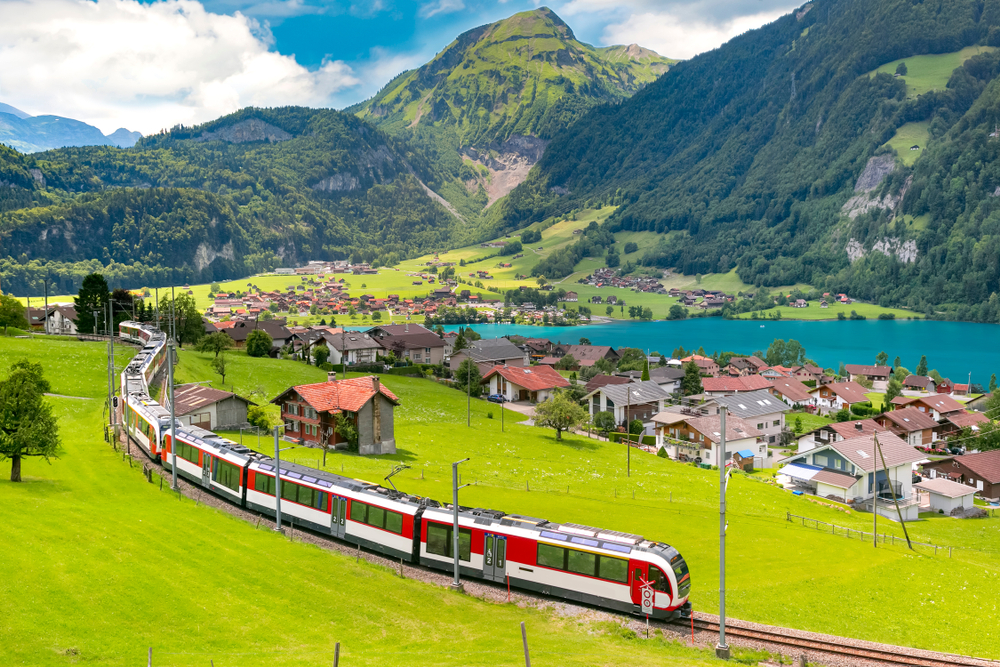
6 Oct 2023
Climate change poses a significant threat to coffee production as suitable land for cultivation diminishes, and bean quality and yields decline. Meanwhile, the coffee industry faces mounting pressure for transparency within its supply chain, with technology emerging as a key enabler. Investors are waking up to social risks, consumer preferences and future developments to improve the industry’s sustainability.
In this issue of #WhyESGMatters, we discuss the importance and methods of achieving more sustainable coffee production, highlighting the role of technology in enhancing supply chain transparency.

What is brewing
From home to popular coffeehouses, coffee lovers across the globe consume over 400bn cups of coffee every year. Nearly 10bn tonnes of coffee is produced annually, primarily concentrated in regions known as the “Coffee Belt”, with the top five producers - Brazil, Vietnam, Colombia, Indonesia and Ethiopia - accounting for over 70% of global production.
Remarkably, small-scale farmers contribute to about 80% of the world’s coffee production, supporting the livelihoods of approximately 125m people. But this popular drink could be at risk. The Intergovernmental Panel on Climate Change (IPCC) predicts a decline in suitable areas for coffee cultivation by 2050. This is supported by several studies indicating that rising temperatures encourage the proliferation of coffee plant pests and diseases, putting the industry in jeopardy.
Headed for trouble
Rising temperature and changing rainfall patterns pose several threats to coffee plantation:
Reduced crop yields: Coffee plants are sensitive to temperature fluctuations, and prolonged heatwaves can hinder their growth and productivity. Arabica and Robusta are the two primary species of coffee cultivated globally. Robusta is relatively less sensitive to heat (but more vulnerable to drought), while temperature plays a crucial role in the development and maturation of Arabica coffee. Arabica plants thrive in the temperature range of 18-21°C, but continuous exposure to temperatures above 30°C can damage them, resulting in decreased yields and compromised bean quality.
The temperature in key coffee-producing regions has already been increasing. For instance, Brazil, the top producer of Arabica, has experienced an increase of 1.16°C in annual mean temperature between 1971 and 2021. A recent study published in the journal PLOS Climate revealed that the sub-optimal conditions for coffee yield have increased since 1980. The last decade was found to be more acute with five of the six most hazardous years occurring since 2010.
The bitter notes
While rising temperature is known to brew trouble for coffee production, the cultivation of coffee is linked to deforestation, further exacerbating climate change. Vast areas of tropical forests are often cleared to meet the growing demand for coffee and create optimal growing conditions. Per the World Resources Institute (WRI), nearly 2m hectares of forest were replaced by coffee plantation between 2001 and 2015. There’re two methods of coffee cultivation: shade-grown (agroforestry system) which is environmentally sustainable, and sun-grown which involves forest clearing and depletes soil nutrients.
In many countries, the coffee industry has already transitioned to full-sun production to meet the growing demand. This shift is partly driven by the commonly held assumption that fungal infections are limited by sun exposure, as well as by the financial appeal it offers. Additionally, shade-providing leguminous tree species have been found to compete with coffee plants for soil and water during severe drought, resulting in mortality of coffee plantation. Stuck in a vicious cycle, deforestation due to coffee plantations not only reduces carbon sinks but also eliminates critical habitats, exacerbating biodiversity loss and climate change.
Water and energy consumption
Coffee production also requires substantial amounts of water across its lifecycle, affecting local communities and ecosystems in water-stressed regions. According to the Food and Agriculture Organisation (FAO), a cup of coffee requires 140 litres of water to grow.[@how-sustainable-is-your-morning-coffee-4] From roasting to brewing, the coffee supply chain guzzles energy, adding to its carbon footprint.
To address these pressing issues, various adaptation measures and sustainable solutions are being implemented. For instance, regenerative agriculture through intercropping helps improve the quality and biodiversity of soil which is beneficial for coffee yield and quality. It also aids in long-term security for farmers who are among the most vulnerable to climate risk, by diversifying outputs and income.
A seven-year study analysing intercropping between macadamia and coffee found a 10% increase in coffee yield under rain-fed conditions, and the highest profitability after the first five harvests in the irrigated coffee plantation regime.[@how-sustainable-is-your-morning-coffee-5] Regenerative agriculture also aids in the reduction of the water footprint of coffee by enhancing soil filtration and retention capacity.
The desire for transparency across consumer goods is growing, and this includes the daily coffee we drink. Pressure from regulators, investors, retailers and consumers is driving the demand for greater traceability in the coffee industry, fuelled by both social and environmental concerns.
Considering the environmental impacts of coffee plantations previously discussed, it’s essential to map the entire supply chain, enabling greater transparency and the collection of important ESG metrics such as emissions, water usage and deforestation. Regulatory developments, such as the EU Deforestation Law, highlight the importance of gathering this information across the entire value chain.
Worker well-being is also a significant consideration in the coffee industry, with heat stress emerging as a growing concern, particularly in agriculture. Southern American countries, which are key coffee producers, have seen a 2x increase in working hours lost since 1995 due to heat stress. This presents a key health and safety risk to coffee farm workers and a threat to global coffee production if precautions are not properly taken.
Technology plays a crucial role in improving transparency and simplifying increasingly complex and dynamic supply chains. Key disruptive technologies are important in the transition to traceable supply chains:
Standards and regulations
Alongside regional food safety requirements, sustainability standards are becoming increasingly important in the coffee market. In the European Union, mandatory requirements encompass aspects include food safety/containments, pesticides and pathogens, among others, as well as additional third-party curated sustainability certifications that aim to demonstrate compliance with social criteria. Well-known certifications include Fairtrade, Rainforest Alliance and Fair for Life.[@how-sustainable-is-your-morning-coffee-6]
Fairtrade aims to make a positive impact on producers and workers across the globe in a range of products, including coffee. Fairtrade Minimum Price sets a floor price for products to safeguard against volatile markets while Fairtrade Premium provides additional funds for farmers and workers to invest in infrastructure, healthcare and social projects. Currently, Fairtrade coffee accounts for around 25% of total coffee sales in the UK, including a significant market presence and consumer support for sustainable and ethically-sourced coffee.[@how-sustainable-is-your-morning-coffee-7]
Individual consumption choices have a significant impact on emissions, waste generations and pollution. Alongside the environmental effect, differences between bean type – Arabica or Robusta – as well as the decision to purchase ground or instant coffee, can have varying environmental costs. Studies show that with respect to the lifecycle of both instant and ground coffee, instant has higher environmental costs than ground as it requires 7-11x more energy.[@how-sustainable-is-your-morning-coffee-8] Globally, instant coffee accounts for more than 34% of retail brewed coffee consumption.[@how-sustainable-is-your-morning-coffee-9]
Ground pods represent 16% of UK coffee sales, and although they provide the consumer the opportunity to create barista-style coffee at home, their sustainability has come under scrutiny. Beyond the emissions generated during the preparation of coffee from the pods, the post-consumer waste associated with pods and capsules contributes to additional emissions and landfill contribution.[@how-sustainable-is-your-morning-coffee-10] We’ve observed retailers switching to aluminum pods and implementing recycling schemes, as well as compostable pods (such as Grind Coffee) to help alleviate risks.

Disposable coffee cups pose an additional environmental risk as the majority are unable to be recycled due to plastic linings and, thus, end up in landfill. In the UK alone, approximately 2.5bn coffee cups are disposed of each year.[@how-sustainable-is-your-morning-coffee-11] Offering consumers with environmentally friendly alternatives and providing monetary incentives for reusable cups have proven to be effective solutions. Studies find that nearly 93% of consumers are willing to bring their own reusable cup if they receive discounts exceeding a certain value, approximately USD0.265.[@how-sustainable-is-your-morning-coffee-12]
A time for coffee innovation
Seeking sustainable coffee has spurred various innovations, such as lab-grown coffee and energy production from waste. Cellular agriculture, for example, offers the possibility to create coffee cells in a lab. This can be of great use to coffee-flavoured products; however, adoption into mainstream coffee drinking remains a social question for consumers.
Additionally, taking demand away from small-holder farms in developing regions risks their livelihoods.[@how-sustainable-is-your-morning-coffee-13] Utilising coffee ground waste is a promising area to alleviate landfill contributions. Combining coffee grounds with polymers creates a material that can be used in the garment industry. Additionally, converting grounds into logs provides an alternative to wood for burning purposes.[@how-sustainable-is-your-morning-coffee-14] Exploring bioenergy production and building material from coffee cups also present opportunities for environmental sustainability.
Reusable coffee cups are commonplace for many regular coffee drinkers. However, more concerted efforts are required to reduce the industry’s overall impact and ensure the reliability of the coffee supply chain. Embracing regenerative agriculture, new coffee species adaptions and technology are opportunities to increase supply chain resilience. Progress in standards and regulations lead to certifications that address growing social risks. Innovative developments in lab-grown coffee and waste recycling create opportunity to reduce environmental impacts. Considering the projected tripling of coffee production requirements by 2050 (World Economic Forum, 2021), it’s imperative to continue driving sustainable practices and innovations within the coffee industry.




This document is prepared by The Hongkong and Shanghai Banking Corporation Limited (‘HBAP’), 1 Queen’s Road Central, Hong Kong. HBAP is incorporated in Hong Kong and is part of the HSBC Group. This document is distributed by HSBC Bank (China) Company Limited, HBAP, HSBC Bank (Singapore) Limited, HSBC Bank (Taiwan) Limited, HSBC Bank Malaysia Berhad (198401015221 (127776-V))/HSBC Amanah Malaysia Berhad (200801006421 (807705-X)), The Hongkong and Shanghai Banking Corporation Limited, India (HSBC India), HSBC Bank Middle East Limited, HSBC UK Bank plc, HSBC Bank plc, Jersey Branch, and HSBC Bank plc, Guernsey Branch, HSBC Private Bank (Suisse) SA, HSBC Private Bank (Suisse) SA DIFC Branch, HSBC Private Bank Suisse SA, South Africa Representative Office, HSBC Financial Services (Lebanon) SAL, HSBC Private banking (Luxembourg) SA, HSBC FinTech Services (Shanghai) Company Limited and The Hongkong and Shanghai Banking Corporation Limited and HSBC Mexico, S.A. Multiple Banking Institution HSBC Financial Group (collectively, the “Distributors”) to their respective clients. This document is for general circulation and information purposes only. This document is not prepared with any particular customers or purposes in mind and does not take into account any investment objectives, financial situation or personal circumstances or needs of any particular customer. HBAP has prepared this document based on publicly available information at the time of preparation from sources it believes to be reliable but it has not independently verified such information. The contents of this document are subject to change without notice. HBAP and the Distributors are not responsible for any loss, damage or other consequences of any kind that you may incur or suffer as a result of, arising from or relating to your use of or reliance on this document. HBAP and the Distributors give no guarantee, representation or warranty as to the accuracy, timeliness or completeness of this document. This document is not investment advice or recommendation nor is it intended to sell investments or services or solicit purchases or subscriptions for them. You should not use or rely on this document in making any investment decision. HBAP and the Distributors are not responsible for such use or reliance by you. You should consult your professional advisor in your jurisdiction if you have any questions regarding the contents of this document. You should not reproduce or further distribute the contents of this document to any person or entity, whether in whole or in part, for any purpose. This document may not be distributed to any jurisdiction where its distribution is unlawful.
The following statement is only applicable to HSBC Bank (Taiwan) Limited with regard to how the publication is distributed to its customers: HSBC Bank (Taiwan) Limited (“the Bank”) shall fulfill the fiduciary duty act as a reasonable person once in exercising offering/conducting ordinary care in offering trust services/business. However, the Bank disclaims any guaranty on the management or operation performance of the trust business.
The following statement is only applicable to by HSBC Bank Australia with regard to how the publication is distributed to its customers: This document is distributed by HSBC Bank Australia Limited ABN 48 006 434 162, AFSL/ACL 232595 (HBAU). HBAP has a Sydney Branch ARBN 117 925 970 AFSL 301737.The statements contained in this document are general in nature and do not constitute investment research or a recommendation, or a statement of opinion (financial product advice) to buy or sell investments. This document has not taken into account your personal objectives, financial situation and needs. Because of that, before acting on the document you should consider its appropriateness to you, with regard to your objectives, financial situation, and needs.
The following statement is only applicable to HSBC Mexico, S.A. Multiple Banking Institution HSBC Financial Group with regard to how the publication is distributed to its customers: This publication is distributed by Wealth Insights of HSBC México, and its objective is for informational purposes only and should not be interpreted as an offer or invitation to buy or sell any security related to financial instruments, investments or other financial product. This communication is not intended to contain an exhaustive description of the considerations that may be important in making a decision to make any change and/or modification to any product, and what is contained or reflected in this report does not constitute, and is not intended to constitute, nor should it be construed as advice, investment advice or a recommendation, offer or solicitation to buy or sell any service, product, security, merchandise, currency or any other asset.
Receiving parties should not consider this document as a substitute for their own judgment. The past performance of the securities or financial instruments mentioned herein is not necessarily indicative of future results. All information, as well as prices indicated, are subject to change without prior notice; Wealth Insights of HSBC Mexico is not obliged to update or keep it current or to give any notification in the event that the information presented here undergoes any update or change. The securities and investment products described herein may not be suitable for sale in all jurisdictions or may not be suitable for some categories of investors.
The information contained in this communication is derived from a variety of sources deemed reliable; however, its accuracy or completeness cannot be guaranteed. HSBC México will not be responsible for any loss or damage of any kind that may arise from transmission errors, inaccuracies, omissions, changes in market factors or conditions, or any other circumstance beyond the control of HSBC. Different HSBC legal entities may carry out distribution of Wealth Insights internationally in accordance with local regulatory requirements. HSBC specifically prohibits the redistribution of this material and is not responsible for any actions that third parties may take to and/or with it.
Mainland China
In mainland China, this document is distributed by HSBC Bank (China) Company Limited (“HBCN”) and HSBC FinTech Services (Shanghai) Company Limited to its customers for general reference only. This document is not, and is not intended to be, for the purpose of providing securities and futures investment advisory services or financial information services, or promoting or selling any wealth management product. This document provides all content and information solely on an "as-is/as-available" basis. You SHOULD consult your own professional adviser if you have any questions regarding this document
Important Information about the Hongkong and Shanghai Banking Corporation Limited, India (“HSBC India”)
HSBC India is a branch of The Hongkong and Shanghai Banking Corporation Limited. HSBC India is a distributor of mutual funds and referrer of investment products from third party entities registered and regulated in India. HSBC India does not distribute investment products to those persons who are either the citizens or residents of United States of America (USA), Canada, Australia or New Zealand or any other jurisdiction where such distribution would be contrary to law or regulation.
The material contained in this document is for general information purposes only and does not constitute investment research or advice or a recommendation to buy or sell investments. Some of the statements contained in this document may be considered forward looking statements which provide current expectations or forecasts of future events. Such forward looking statements are not guarantees of future performance or events and involve risks and uncertainties. Actual results may differ materially from those described in such forward-looking statements as a result of various factors. HSBC India does not undertake any obligation to update the forward-looking statements contained herein, or to update the reasons why actual results could differ from those projected in the forward-looking statements. Investments are subject to market risk, read all investment related documents carefully.
Important information on ESG and sustainable investing
In broad terms “ESG and sustainable investing” products include investment approaches or instruments which consider environmental, social, governance and/or other sustainability factors to varying degrees. Certain instruments we classify as sustainable may be in the process of changing to deliver sustainability outcomes. There is no guarantee that ESG and Sustainable investing products will produce returns similar to those which don’t consider these factors. ESG and Sustainable investing products may diverge from traditional market benchmarks. In addition, there is no standard definition of, or measurement criteria for, ESG and Sustainable investing or the impact of ESG and Sustainable investing products. ESG and Sustainable investing and related impact measurement criteria are (a) highly subjective and (b) may vary significantly across and within sectors.
HSBC may rely on measurement criteria devised and reported by third party providers or issuers. HSBC does not always conduct its own specific due diligence in relation to measurement criteria. There is no guarantee: (a) that the nature of the ESG / sustainability impact or measurement criteria of an investment will be aligned with any particular investor’s sustainability goals; or (b) that the stated level or target level of ESG / sustainability impact will be achieved. ESG and Sustainable investing is an evolving area and new regulations are being developed which will affect how investments can be categorised or labelled. An investment which is considered to fulfil sustainable criteria today may not meet those criteria at some point in the future.
© Copyright 2024. The Hongkong and Shanghai Banking Corporation Limited, ALL RIGHTS RESERVED.
No part of this document or video may be reproduced, stored in a retrieval system, or transmitted, on any form or by any means, electronic, mechanical, photocopying, recording or otherwise, without the prior written permission of The Hongkong and Shanghai Banking Corporation Limited.